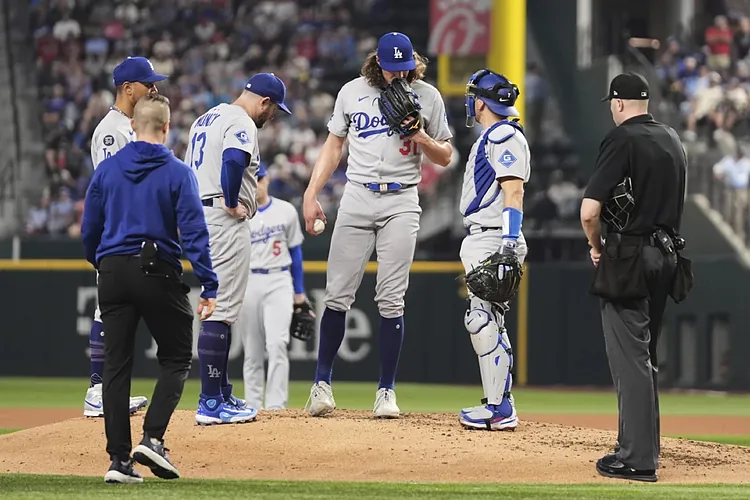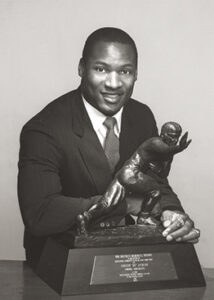
The Los Angeles Dodgers, a team known for its rich history, dynamic roster, and focus on player development, recently made the decision to move on from veteran catcher Austin Barnes. The decision was a tough one, as Barnes had been an integral part of the team for several seasons. However, in the fast-paced world of Major League Baseball, decisions like this are often made with an eye toward the future, and in this case, the future is bright for the Dodgers with the rise of Dalton Rushing, a highly touted young catcher whose potential has excited the organization.
Austin Barnes, who joined the Dodgers in 2015, has been a dependable presence behind the plate. Known for his excellent game-calling skills, ability to manage pitchers, and defensive prowess, Barnes has always been a valuable contributor to the Dodgers’ success. While his offensive numbers never truly reached elite levels, he was consistently solid in a backup role, providing leadership and a steady hand to a pitching staff that has included some of the league’s top talents.
Over the years, Barnes has found his niche with the Dodgers as a reliable backup to starting catcher Will Smith. His familiarity with the pitching staff, his ability to frame pitches, and his knowledge of how to handle high-pressure situations made him an indispensable member of the team. Yet, despite these contributions, it became clear that the Dodgers were looking to the future and that future, it seemed, would soon involve a changing of the guard behind the plate.
Enter Dalton Rushing.
Rushing, a 23-year-old catcher from Louisville, Kentucky, has rapidly ascended through the Dodgers’ minor league ranks, and his performance in the minors has captured the attention of the organization. Selected by the Dodgers in the 2021 MLB Draft, Rushing quickly established himself as one of the top prospects in the system. His bat has been a standout feature, with a potent combination of power and plate discipline. While his defense behind the plate still requires refinement, Rushing’s offensive upside has been too good for the Dodgers to ignore.
In many ways, Dalton Rushing represents the changing landscape of the Dodgers’ roster. The organization has long been known for its ability to develop homegrown talent, and Rushing’s rise is a perfect example of that philosophy in action. Over the past two seasons, Rushing has impressed with his bat speed, ability to hit for power, and an innate understanding of the strike zone. His offensive prowess, particularly his ability to hit for both average and power, made him one of the most exciting prospects in the Dodgers’ farm system. As the 2024 season approached, it became apparent that Rushing’s time in the minors was drawing to a close, and the Dodgers would need to make room for him on the big league roster.
In a league that places a premium on strong offensive production, the Dodgers saw Rushing as a potential key piece in their future lineup. The decision to move on from Barnes, while difficult, was a logical one given the team’s long-term vision. As much as Barnes had contributed to the Dodgers’ success, Rushing’s potential to be a long-term solution at catcher – and his ability to bring more to the table offensively – made it clear that the team needed to make the transition.
For Barnes, the decision to part ways with the Dodgers must have been a bittersweet one. As a player who had spent nearly a decade in the organization, he undoubtedly built deep connections with teammates, coaches, and staff members. His role as a trusted mentor to the younger players and his rapport with the pitching staff made him a beloved figure in the clubhouse. Barnes had been a part of the Dodgers’ playoff teams, including their 2020 World Series victory, and his steady presence behind the plate had been crucial during many important moments.
Yet, as with any professional athlete, the desire for more playing time and a continued role on a competitive team is always present. Moving on from the Dodgers may provide Barnes with an opportunity to latch on with another organization, perhaps one that is in need of a veteran presence behind the plate. For Barnes, the road ahead will likely involve proving that he can still contribute at the Major League level, and given his track record, there is little doubt that he can find a new team where his experience will be valued.
For the Dodgers, the move signals a new chapter. The team’s commitment to building a sustainable and competitive roster is evident in their decision to prioritize the development of young talent like Rushing. While Barnes’ departure marks the end of an era in many ways, the organization’s ability to transition from one era to the next seamlessly is a testament to their forward-thinking approach.
The Dodgers’ decision to make room for Dalton Rushing also underscores a broader trend in Major League Baseball: the emphasis on player development and the increasing role of analytics in roster decisions. The game of baseball is evolving, and teams are looking for players who can contribute not only defensively but also offensively, particularly at positions like catcher. While Barnes was an exceptional defensive catcher, Rushing’s offensive potential has become a game-changer for the Dodgers, and the team is betting that his bat will play at the highest level.
In terms of Rushing’s development, he is far from a finished product. As with any young player, there will be growing pains as he adapts to the demands of the Major League Baseball season. His defense behind the plate will be scrutinized, and he will need to continue to work on his receiving skills and game-calling ability. However, the Dodgers have shown time and again that they are willing to invest in young players and give them the opportunity to grow. If Rushing can continue to develop and refine his skills, there’s no reason why he can’t become a cornerstone of the Dodgers’ roster for years to come.
From a broader perspective, the decision to move on from Austin Barnes is a reflection of the Dodgers’ broader strategy of blending experience with youth. The team has always valued a deep roster that can compete on multiple fronts, and by integrating rising stars like Rushing into the fold, they are positioning themselves for long-term success. The Dodgers’ front office has consistently shown that they are willing to make tough decisions in order to maximize their potential, and this move is just the latest example of their commitment to winning championships.
For Dodgers fans, the transition from Barnes to Rushing is both exciting and emotional. Barnes has been a fan favorite, and his departure will surely leave a hole in the hearts of many who appreciated his contributions to the team. However, the arrival of Dalton Rushing signals a new era for the Dodgers, one that promises to be filled with new challenges, opportunities, and the potential for greatness.
In conclusion, the Los Angeles Dodgers’ decision to move on from veteran catcher Austin Barnes in favor of rising star Dalton Rushing is a bold but necessary move in the ever-evolving landscape of Major League Baseball. While Barnes’ departure marks the end of a chapter for the Dodgers, it also signals the beginning of a new one, filled with promise and potential. With Rushing’s offensive upside and the Dodgers’ proven track record of player development, the team is poised to continue its success for years to come. The transition may be difficult, but for the Dodgers, it represents the future of the franchise – a future that looks bright indeed.





